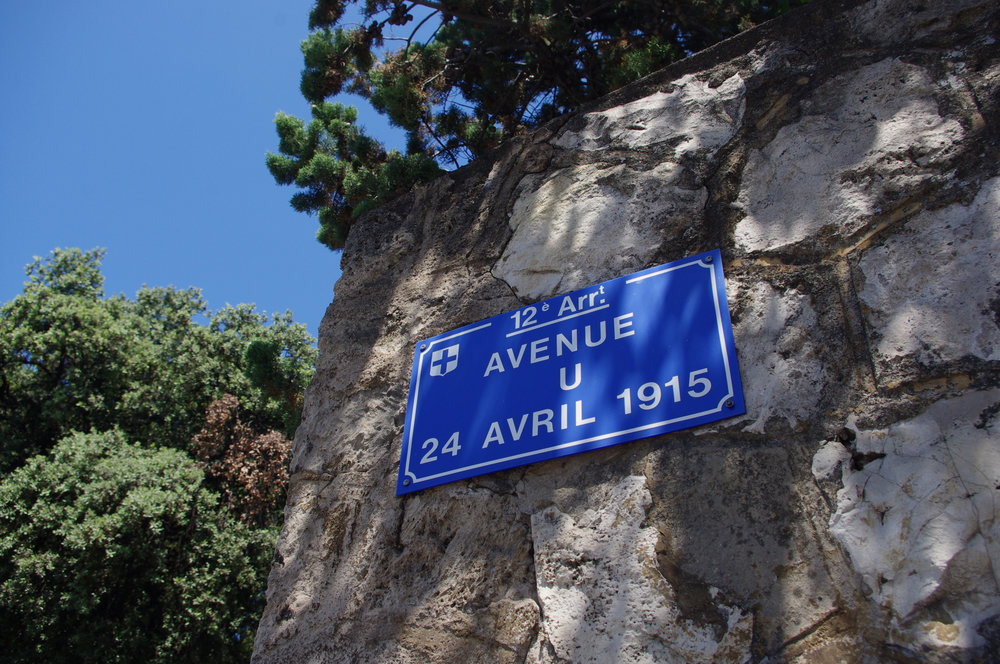Marseille and its surrounding towns
ADS 2018 Pilot project
The first mentions of an Armenian presence in Marseille go back to the end of the 16th century, when Armenian merchants from Julfa in Iran travelled to the city. However, it was in 1612 when the first Armenian family, the d’Arménys, settled in Marseille. The patriarch of the family was Antoine d’Armény, who established ties with Louis Fréjus, one of the most prominent merchants in Marseille, in order to trade in silk, which Armenians brought from the “East”. Towards the end of the 17th century, the Armenian community in Marseille grew to around 400 people.
The Armenian quarter in Marseille was established behind the current Hôtel de Ville, where one found repositories belonging to the merchants and an Armenian chapel. The first Armenian printing house was established in 1669 by Archbishop Oskan Yerevantsi. It was located on rue de la Loge.
A map showing the continuing Armenian presence in Marseille. Carte sensible de la présence arménienne à Marseille " (All photos and map by Maida Chavak).
Armenians played a key role in the diplomacy between France and Persia. A consul, by the name of Hakobian, was sent to run affairs in Marseille in 1715. From 1850 onwards, Armenian merchants from commercial centres in the Ottoman Empire began to travel to Marseille and establish their businesses there, as well as a sense of community life. Most of the Armenian institutions at the time were centred in rue Saint-Jacques, rue de l’Ormeau and rue Stanislas Torrents.
Marseille saw an influx of Armenian migrants from the Ottoman Empire during the massacres of 1894-1896 and the Genocide at the start of the 20th century. They came without any identification. The Armenian Church coordinated with the French authorities to obtain papers for the refugees, both birth and baptism certificates. A number of these still exist, attesting to the arrival of Armenian refugees to the city. Lodging and accommodation were major issues for thousands of destitute Armenians. They were sent to military camps transformed into refugee camps. The largest of these was called Camp Oddo, taking in around 5,500 refugees between 1922 and 1927. Other such refugee camps taking in Armenians included Camp Sainte-Anne and Sainte-Marthe.
Gradually Armenians settled in the north of Marseille, near Saint-Louis, Saint-André and Saint-Antoine; rue de Lyon, boulevard Oddo, Saint-Henri, Saint-Jérôme, Saint-Julien, Saint-Loup, Saint-Marguerite, Campagne Frèze and, the most notable of all, Beaumont. In the 1920s, the community built churches, clubs and cultural centres. The Armenian Church, under the leadership of Bishop Krikoris Balakian, and the three diapsora political parties played pivotal roles in organising and developing the life of the community.
The area of Beaumont in Marseille has been a primary centre for the Armenian community of the city. The community began to establish itself there when the survivors of the Genocide grew tired of the conditions in the refugee camps and sought lodging away from the centre of the city. Many bought plots of land in the area with credit in accordance with the Property Law of the time. There are stories of how Armenians would build their houses in Beaumont in the evenings and weekends when they were off their regular work. Beaumont was seen as a space where Armenians could start anew and have their own pocket of territory where the community would flourish. St Gregory the Illuminator church was constructed in 1932. The Armenian language was taught there once a week, as well as at the Evangelical Armenian Church.
Armenians in Beaumont, today around 15-17 thousand, are mostly artisans, craftsmen, shoemakers and businessmen. Two Armenian schools, Hamaskaïne, a bilingual French-Armenian school established in 1980, and Notre-Dame-du-Sacré-Coeur, continue to function. A Genocide memorial was built in 2006 and 100 almond and pomegranate trees were planted nearby in memory of the victims at the Parc du Souvenir.
A number of Armenian organisations continue to preserve a vibrant community life, including UGAB (AGBU), functioning in Marseille since 1910; Hamaskaïne Cultural Association; Agoumb, the club of the Armenian Revolutionary Federation (ARF); ARAM, established by Jean Garbis Artin, documenting Armenian presence in Marseille for students, researchers, journalists and other interested individuals; UGA-Ardziv (Armenian General Union), a football club created in 1924 at Camp Oddo and merged with the Ardziv lub; the Ani Cultural Centre, established in 1987 by Jean Daniel Sahagian, pastor of the Armenian Evangelical Church of Beaumont, focusing on Armenian culture and Christianity.
Avenue du 24 avril 1915 dans le quartier de Beaumont.
Guide destiné aux arméniens nouvellement arrivés à Marseille, en langue arméniene, 1931 - Collection Aram

